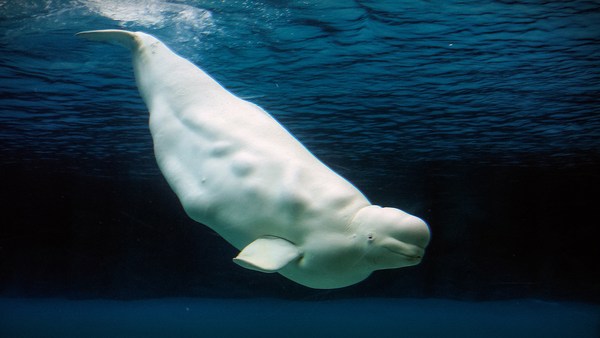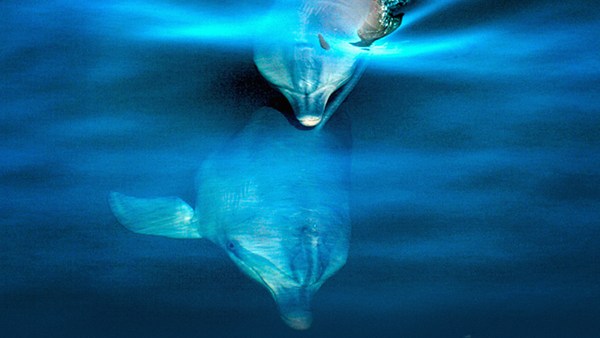To be a marine biologist is a wonderful thing. I get to live in two universes. When I go to bed, I don't know to which world my dreams will take me. And when I'm underwater, I'm weightless, I can move in three dimensions. I can spend all day staring into the blue or marveling at the extraordinary, beautiful, mysterious, sometimes fearsome creatures that live in the sea. To be a human underwater is a completely different sensory experience. But it also strikes fear into me, not me as a human, but me as the fish that I spend my life trying to understand. Because the ocean can be a place full of danger and full of seemingly impossible challenges. Let me give you the example of the perilous life cycle of a coral reef fish. So we're all familiar with the brightly colored beautiful fish that live on coral reefs - cities of life full of color. But each year, these fish produce eggs, and the eggs hatch into tiny, almost microscopic larvae, and they spend several weeks at sea developing, only the size of a grain of rice. And after about two or three weeks, they're competent, ready to return to a coral reef where hopefully, once they found the right reef, they can gradually mature and join their adult community. Now, this seems paradoxical: you live in the perfect environment, and yet you send your offspring out to sea. Why would that be so? I've spent my life trying to understand some of the processes that make this life cycle possible. In particular, how to fish find a reef? You're out at sea, at the mercy of ocean currents. How on earth, if you're the size of a grain of rice, do you find home? How do you choose the right place to live? How do you find a hiding place? These are the challenges that I try to tackle with some of the research that I do. Now, how would you do it? If you were this tiny fish at sea, what what information would you want to try and make that life cycle possible? Well, we know that some fish are able to smell different components of their environment. Some fish are able to look at the position of the sun in the sky, even the way sunlight shines through the clouds, perhaps even use celestial nighttime visual cues. Some fish even have a magnetic sense. So is that enough information to get these fish home? Well certainly, one thing that they probably can't use is sound, right? 60 years ago, Jacques Cousteau brought into the living rooms of the world, for the first time, the wonder of our underwater world. He invented scuba, to be able to take cameras underwater and beam those images back to people around the world. It was a remarkable film in so many ways, except perhaps for the title. You see, Jacques Cousteau told us that the ocean was a silent world. But when we go into the ocean, we know that's not true. Without scuba, we hear whales singing. This is the love song of a humpback whale. And whales can communicate over tens of miles, sometimes hundreds of miles, as they interact with each other. When we look on a coral reef, we realize it's not just whales and dolphins making sound; the fish can speak too. Fish produce popping, grunting, whooping, trumpeting sounds, and they do this to warn each other of predators, to be able to call each other over when they find food, and sometimes, particularly around the breeding season, to try and really impress each other. And so they have some amazing songs within the world of fish. Here's some of the croaking sounds of sergeant majors, the whooping sound of an ambo-damselfish and the deep grunting love song, in this case of a cod. So fish use sound; it's essential to their lives. And it's not even just the fish. When we start looking at the invertebrates that live on the reef too, we realize that lobsters can play their antennae like a fiddler would play the violin, and snapping shrimp, that probably are no bigger than the size of your thumb, with a claw no bigger than the size of your thumbnail, are able to produce one of the loudest underwater explosions every time they open their claw and push a bubble forwards into the water which implodes with a flash of light and an enormous bang. And all together, that creates a crackling sound that gives coral reefs its soundscape. So 18 years ago, I asked a question which, at the time, almost everybody I was working with on the Great Barrier Reef thought was crazy: is it possible that fish could use sound as a way of finding their way home? Now, to ask that question, my first approach was to take light traps - light traps are bright boxes with clear glass windows which have slits in them, like letter boxes - and when you shine a bright light underwater on the edge of the reef, you can intercept the larval fish, the baby fish, as they come back to the reef. Many fish, like moths, are attracted to light, and we can catch them in our traps and we can count them as they return. But just to mix it up a little bit, I then hung underneath a trap a speaker. These are underwater speakers sold for synchronized-swimming teams to be able to keep beat underwater, but we use these speakers to playback recordings of coral reefs, to ask the question, "Are fish, at this tiny early stage in their life, several weeks old, attracted to coral reef sound?" And sure enough, three months later, putting these traps out night after night, we found that we caught more than twice as many fish in our noisy traps compared to the quiet ones. And then, to test whether this really was enough for a fish to choose where it wanted to make its home, we hung the speakers over small piles of dead coral rubble, artificial reefs that we built on the sand flats. And sure enough, the fish came swimming in when we were playing our sound. So sound is clearly a cue that these fish were using to hear their way home. So I've spent the last 15 years listening to the ocean, trying to interpret what these fish can hear. What is it, what information is available that gives fish this sensory experience that encourages them home? Now, as a marine biologist, one of the privileges is getting to play with some very big, very expensive toys. And I'm just going to share two of mine with you today. The first is the good ship Masifa, which we invented as a way of being able to sail a hydrophone, an underwater microphone, over the reefs so that we could start to understand the rich tapestry of sound that's made as you travel from different types of reef. And then the second one is my hydrosaur. This is a - you could see at the time that funding for marine bio acoustics was in its early stages. This is an inflatable dinosaur, but I was able to strap my microphone to this and leave it out overnight, and by doing that, we started to realize there were patterns in the soundscape. At dusk, all of the nocturnal fish, the predators, emerge from their caves, and they start calling to each other as they go looking for food. So we get a dusk chorus. And then at dawn, these fish disappear back into the reef but out come all the daytime fish, and they've got to reestablish their territories, much like birds would do in a forest, and so we get a dawn chorus too. The reef is alive with noise, and that noise has patterns. And we've explored this by combining recordings with underwater surveys. And with our underwater surveys, we realize that we can hear whether there are coral there. We can hear which species live there. We realize that the fish at sea are doing much what we would do if we were moving to a new city: we'd perhaps get on the internet and do some research into different suburbs that we might want to live in. We think fish can do the same thing by listening to their environment and choosing where they want to live. We now know that reefs all sound different; they have signature sounds. Baby fish can select the best habitat for their kind by using sound. And amazingly, it turns out so can many other animals on coral reefs: crabs, lobsters, clams, oysters, even corals themselves. Here's a few places that we've worked. This is Balicasag, which is a marine protected area in the Philippines. You can see it's full of life. It's highly protected, there's no fishing, and as a result, when we listen to it, it's a wonderful soundscape. You can hear the fish communicating, you can hear the snapping shrimp. Now sadly, if we go three bays around the corner to Bilang-Bilangan, we find a more typical Filipino reef. This is a reef that's been heavily overfished, so there are no herbivores to graze away at the algae, which now smothers the reef. You can even see craters from dynamite fishing, and when we listen to it ... you can just about hear it. So a tiny fish would have to pretty much swim into this reef before it found it. The next generation are not coming home. We are changing the soundtrack of the ocean through overfishing and poor environmental protection. Let's go somewhere better: to the Great Barrier Reef. This is, for marine biologists, the benchmark. This is where we go to see what coral reefs once were like, what coral reefs can be like with really effective management, highly protected marine reserves, long distances away from cities, from pollution, and as a result, beautiful bustling underwater cities full of life. You can hear the Great Barrier Reef; it's a wonderful thing. And we've studied this for 15 years to make reference to the reefs around the world. At least, we have until three years ago, when tragedy struck. With painful predictability, we saw the water temperature starting to rise. Oceanographic conditions meant the water was staying in one location, and for three weeks, the Great Barrier Reef cooked. We saw the reef in front of our eyes dying. And when we go back to the Great Barrier Reef now, we see in the northern part, where we do our research, 80% of it is dead. When we listen to that reef, it's 75% quieter. The snapping shrimp have gone. The complexity, the diversity of the sound is missing; it's become an acoustic desert. And so we realize, with climate change, we are changing the soundtrack of the ocean. These, in some ways, are gradual changes - overfishing, poor management, climate change - but we also realize when we take our recordings on a day-to-day basis, we change the soundtrack of the ocean by driving motor boats around. Millions of motor boats every day drive around coral reef environments, with engines that rattle, with propellers that cavitate, creating bubbles which screech in the water as they burst. And we've realized that their sound causes stress to all of the animals that experience it. And with stress comes poor decisions: the fish are no longer able to respond to predators, to be able to find food, to be able to court, to be able to successfully reproduce. This motorboat noise is a form of noise pollution that makes us realize we are changing the soundtrack of the ocean. Now, if this was the end of the talk, it would be a sorry tale, but as a scientist, I asked myself, "What is my role? Why am I trying to do the science that I'm doing? Is my duty simply to monitor, to measure, to assess how the world is changing and to report that? Or can we take that knowledge, and can we actually turn it into practical solutions?" So here's the spiny chromis, wonderful fish, lives on the Great Barrier Reef in monogamous pairs, a male and female living together. They lay their eggs in the reef, and their eggs hatch, and unusually, they bring their young through those first few weeks on the reef, they protect them, and you can see their baby fish out here, the larvae of the spiny chromis. Now, if we monitor how well they do near to boating channels, we realize that that motorboat noise means the adults don't feed as well, they don't defend the larvae against predators in the same way, and the larvae fail to develop, less larvae make it through. So, is that a real tragic story of how with noise pollution we're affecting reproduction? Or could it be that actually, if we turn it on its head, we realize our comparison is what happens if the boats aren't there: we see more reproduction, we see better behavior in the adults, more feeding, more defense against predators. Could we be talking here about a story of acoustic protection? If we go to the Great Barrier Reef and we play those sad recordings of the current state of the Great Barrier Reef, the fish no longer arrive in the numbers that we would hope for. If we play the recordings of the Great Barrier Reef as it used to be, the fish still come. So here, are we talking about a story of the loss of a sensory cue that's essential to close the loop of the life cycle? Or could this be a story about the potential value of acoustic enrichment? This is something that my group now are actively pursuing around the world, and we're hugely excited that there are tools with acoustics that we're realizing might be part of the solution. So we realize it's our gift to change the soundtrack of the ocean in this generation, but to change it for the better, not the worse. With technology, we can improve the sound outputs of boat engines - modern engines are far quieter. With environmental protection, we can keep boats away from breeding grounds, from nursery grounds. We can give quiet nights to allow the fish to come in and settle. And with acoustic enrichment, we can potentially accelerate the recovery of habitats that have been worst hit. Thank you for listening. (Applause)
Related talks

Mathias Basner: Why noise is bad for your health -- and what you can do about it

Kate Stafford: How human noise affects ocean habitats

Peter Tyack: The intriguing sound of marine mammals

Jeremy Jackson: How we wrecked the ocean

Mike Gil: Could fish social networks help us save coral reefs?
